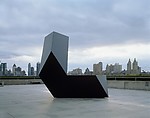Amaryllis
Tony Smith American
Not on view
Tony Smith worked as an architect for over twenty years (1938–60), so it is not surprising that he approached sculpture in an architectural manner, as something to be designed with mathematical precision from geometric components. His method was to manipulate numerous small geometric solids that were cut and pasted from cardboard until a satisfactory arrangement emerged. The small cardboard maquette, or sometimes a larger version of it, was then sent to the foundry to be enlarged and cast in steel. The result often startled the artist, as the work loomed to monumental proportions.
Smith's large black painted-steel sculpture Amaryllis exemplifies his style and suggests the expressive possibilities and visual intricacies that could be achieved with a relatively limited number of elements. As in many of the artist's pieces, a single geometric form (in this case, a tetrahedron forming a triangular-based pyramid) is repeated to create a larger, more irregular configuration. In Amaryllis two of these composite forms, identical in size and shape, are joined together: one piece is placed horizontally on the ground; the other extends vertically at an angle from the top. As the viewer moves around the sculpture, its configuration changes constantly—stretching and contracting, balancing and unbalancing. This eccentricity of form reminded the artist of the unusual organic shape of an amaryllis plant. Smith has often been associated with the Minimalist artists of the 1960s. Unlike them, he did not negate content, but was always receptive to the idea of abstract sculpture evoking objects and attitudes.
Due to rights restrictions, this image cannot be enlarged, viewed at full screen, or downloaded.

